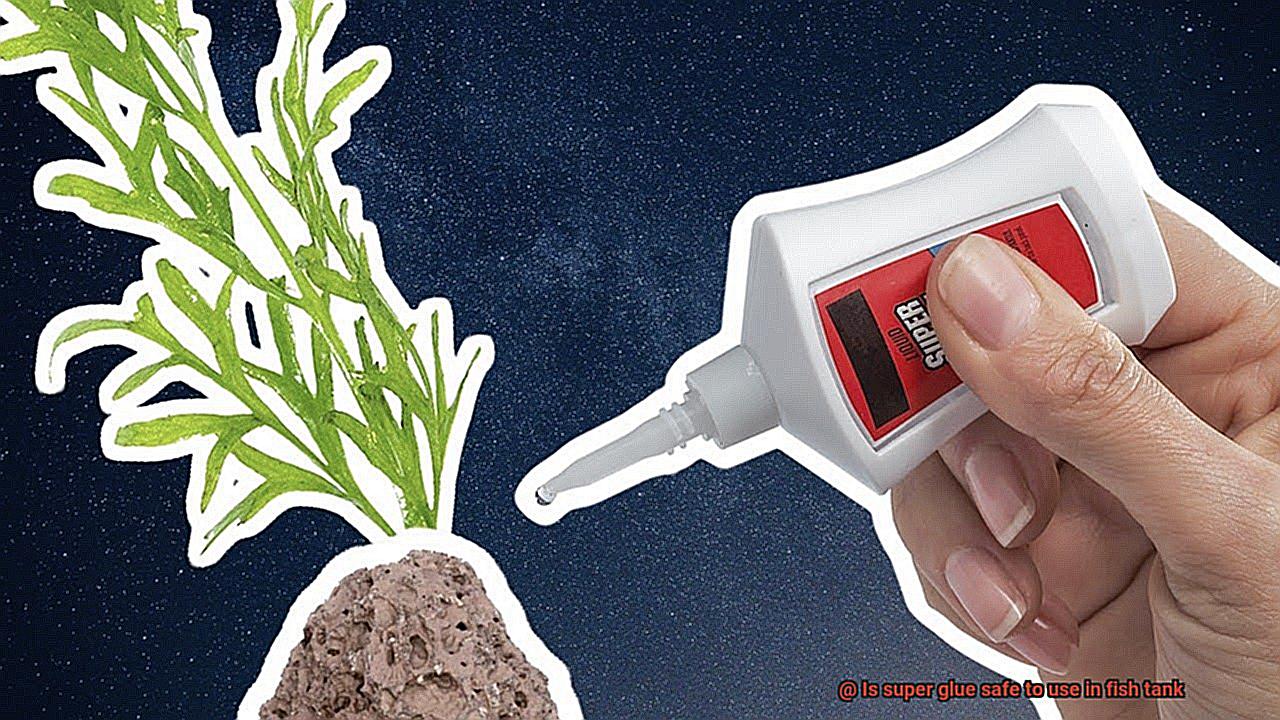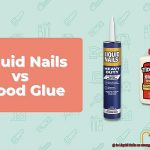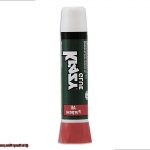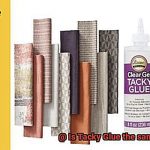Hey there, fellow fish lovers. Are you in a bind and need to secure a decoration in your tank? You may have considered using super glue as a quick fix. But before you reach for that trusty tube, let’s talk about whether or not it’s safe to use in your fish tank.
Sure, super glue is used in all sorts of everyday applications, but when it comes to aquatic environments, things get a little more complicated. Will it mess with the water chemistry? Could it harm your finned friends or any other critters sharing their space? These are important questions to ask before diving into the world of aquarium adhesives.
In this post, we’ll explore the potential risks of using super glue in your fish tank and offer up some safer alternatives for securing decorations. By the end of this article, you’ll be equipped with all the knowledge you need to keep your underwater buddies happy and healthy. So let’s dive deep into the world of aquarium adhesives and find out if super glue is truly safe for our scaly friends.
What is Super Glue?
Contents
- 1 What is Super Glue?
- 2 Is Super Glue Safe for Aquatic Life?
- 3 Choosing the Right Super Glue
- 4 Applying Super Glue Correctly
- 5 How to Ensure Safety When Using Super Glue in a Fish Tank
- 6 Benefits of Using Super Glue in a Fish Tank
- 7 Precautions to Take When Using Super Glue in a Fish Tank
- 8 Alternatives to Using Super Glue in a Fish Tank
- 9 Conclusion
Super Glue, also known as cyanoacrylate adhesive, is a wonder adhesive that has revolutionized the world of DIY repairs and household projects. This fast-drying and incredibly strong adhesive was first invented by Dr. Harry Coover in 1942 as a clear plastic for gun sights during World War II. However, it wasn’t until later that the exceptional bonding properties of Super Glue were discovered, making it a popular household adhesive.
To create this adhesive, cyanoacrylate monomers are combined with an activator or stabilizer to produce a liquid that hardens when it comes into contact with moisture. This results in an incredibly strong adhesive that can bond almost any material together in just a matter of seconds. And what’s more, Super Glue is waterproof and heat-resistant, making it ideal for use in a wide range of applications.
But not all Super Glues are created equal. Some brands contain additives like solvents that can be harmful to fish and other aquatic animals. Therefore, it is crucial to choose the right type of Super Glue when using it inside a fish tank.
Most commercial super glues are made from non-toxic cyanoacrylate, making them generally safe to use in fish tanks. However, it is essential to choose a brand that does not contain any harmful additives and is labeled “aquarium safe” or “reef safe.” You can also check with your local aquarium store or online forums to see what brands other aquarium hobbyists recommend.
When using Super Glue in a fish tank, it is vital to apply it correctly. This means applying the glue in a well-ventilated area away from the tank and letting it dry completely before placing any items back in the water. Doing this will allow any remaining fumes to dissipate and prevent the glue from leaching into the water.
Is Super Glue Safe for Aquatic Life?
The answer is complex, and while it can be a powerful adhesive that bonds materials almost instantly, it’s essential to understand its potential risks when used in a fish tank.
Super glue contains cyanoacrylates, an acrylic resin that undergoes a chemical reaction when exposed to moisture, producing heat and fumes that can be harmful to aquatic life. Even if you choose a brand labeled “aquarium safe,” there is still a risk of toxic substances being released into the water over time, which can adversely affect your aquatic pets’ health.
Ingestion is another concern when using super glue in a fish tank. Fish may mistake the glue for food or become entangled in it, leading to severe health problems or death. Hence, it is crucial to exercise caution when selecting an adhesive for your fish tank.
To minimize these risks, always allow the glue to dry entirely before placing any items back into the water. Monitor your tank carefully for any signs of harm to your aquatic pets, such as changes in their behavior or appearance. It may also be safer to opt for alternative methods such as silicone or epoxy-based adhesives designed explicitly for aquarium use.
These alternatives are less likely to release harmful substances into the water and have lower risks of ingestion by aquatic animals. By taking these precautions, you can ensure the safety and well-being of your aquatic pets.
Choosing the Right Super Glue
Super glue might seem like the perfect fix, but choosing the right one is crucial for the safety of your aquatic pets. As an expert on selecting the best super glue for fish tanks, here are some essential factors to consider.
First and foremost, always choose a glue labeled as aquarium-safe. This means it’s been formulated specifically to be non-toxic and safe for aquatic environments. Secondly, consider the type of material you’ll be bonding in your fish tank. Different super glues work better on certain materials than others, so select one that suits your specific needs.
The curing time of the glue is also important to consider. If you need fast repairs or adjustments, opt for a super glue that dries quickly. However, keep in mind that faster-drying glues may not have a long lifespan compared to slower-drying ones. Additionally, make sure the glue creates a strong and long-lasting bond that can withstand the underwater environment of your fish tank. Heavy-duty bonding super glues are the most durable options available.
Applying Super Glue Correctly
Super glue can be a lifesaver when it comes to repairing decorations and equipment inside your fish tank. However, it’s essential to apply it correctly to avoid any harm to your aquatic creatures. As an expert in fish tank maintenance, I have some valuable tips on how to use super glue safely and effectively in your aquarium.
Choosing the Right Type of Super Glue
The first step is to choose the right type of super glue. Look for a cyanoacrylate-based glue that does not contain any harmful chemicals like methanol or acetone. These chemicals can leach into the water and cause harm to your fish. Always read the label carefully before buying any super glue for your aquarium.
Cleaning and Drying the Surface
Before applying the glue, ensure that the surface is clean and dry. Any debris or moisture on the surface can interfere with the bonding process and lead to weak bonds. Use a clean cloth to wipe down the area you want to glue and let it dry completely. This will ensure that the glue adheres properly.
Applying the Glue Sparingly
When using super glue in your fish tank, remember that less is more. Apply a small amount of glue to one surface and press the two surfaces together firmly for a few seconds. Avoid applying too much glue as this can lead to excess glue getting into the water and harming your fish.

Let it Cure Fully
After applying the super glue, give it enough time to cure fully before reintroducing any aquatic creatures back into the tank. Cyanoacrylate-based glues typically take around 24 hours to cure completely. It’s best to wait until this time has passed before reintroducing fish or other aquatic animals back into the tank.
How to Ensure Safety When Using Super Glue in a Fish Tank
Super glue may seem like a convenient solution, but safety should always be the top priority when it comes to your aquatic environment. Here are five sub-sections with tips on how to ensure safety when using super glue in your fish tank:
Choose an aquarium-safe brand
Not all super glues are created equal. Look for brands that are specifically labeled as “aquarium safe” or “reef safe.” These types of glue are formulated without harmful additives or solvents that could harm your fish. Make sure to do your research and choose a brand that you trust.
Clean and dry the area thoroughly
Before applying the glue, it’s crucial to clean the area thoroughly with an aquarium-safe cleaner and dry it completely. Any debris or moisture can interfere with the bonding process and potentially harm your fish. Use a clean cloth or paper towel to wipe down the area and let it air dry completely before proceeding.
Apply sparingly and precisely
When applying the glue, use small amounts and apply it in a thin layer. Avoid applying too much glue at once, as this can create a thick layer that takes longer to dry and may be more likely to harm your fish. It is also crucial to keep the glue away from any living creatures in the tank, including plants and coral.
Wait for it to dry completely
Allow the glue to dry completely before adding any water back into the tank. This will prevent any chemicals from being released into the water. Depending on the type of glue used and the size of the application, this may take anywhere from a few hours to several days. Be patient and do not rush the process, as allowing the glue to fully cure is essential for ensuring its safety.
Prioritize safety over convenience
While using super glue can be a convenient solution for repairs, it’s important to prioritize safety over convenience. Take the necessary precautions, such as choosing an aquarium-safe brand and allowing the glue to fully cure before reintroducing any fish or other animals into the tank. Remember, the health and well-being of your aquatic creatures should always come first.
Benefits of Using Super Glue in a Fish Tank
Super glue may be the solution you’ve been looking for. As an expert in fish tank care, I can attest to the numerous benefits of using super glue in a fish tank when done correctly.
One of the main advantages of using super glue is its ability to bond and seal materials together quickly and effectively. This ensures a secure attachment without the need for potentially harmful wires or string. Moreover, super glue provides a long-lasting hold, so you won’t have to worry about your decor or plants coming loose and harming your fish.
Another benefit of using super glue is that it is non-toxic when fully cured. Unlike traditional silicone sealants that contain hazardous chemicals that can leach into the water and harm your aquatic creatures, super glue becomes chemically inert and safe for use in a fish tank environment. This makes it a safer alternative for those who prioritize the health and well-being of their fish.
In addition to being non-toxic, super glue can be more cost-effective than other sealants such as aquarium-safe silicone. A small bottle of super glue can go a long way, and it’s often less expensive than larger tubes of silicone. This makes it an attractive option for those on a budget or those who need to make quick repairs or adjustments to their tank.
However, it’s crucial to use super glue with caution and in moderation. Overuse or improper use can still pose risks to your fish and their environment. Always choose an aquarium-safe brand, clean and dry the area thoroughly before applying, and wait for it to dry completely before reintroducing your fish.
Precautions to Take When Using Super Glue in a Fish Tank
While super glue may seem like an easy and cost-effective solution, it’s crucial to take some precautions to ensure the safety of your fish.
The first step in using super glue in a fish tank is choosing the right type. Look for cyanoacrylate-based glue labeled as “aquarium safe” or “reef safe”. Using the wrong type of glue can be harmful to your fish and other aquatic organisms.
Before applying the glue, make sure the area is clean and dry. Debris or moisture can affect its bonding ability and may harm your fish if ingested. If possible, remove the affected item from the tank and clean it thoroughly before applying the glue.
When applying super glue in a fish tank, less is more. Over-applying it can create a chemical reaction that may harm your fish. Also, be careful not to get the glue on living organisms in the tank, such as plants or corals, which can cause damage or death.
Once you’ve applied the glue, wait for it to dry completely before reintroducing the item back into the tank. This ensures that any remaining fumes or chemicals have dissipated, making it safe for your fish.
To summarize, here are some key tips to follow when using super glue in a fish tank:
- Choose cyanoacrylate-based glue labeled as “aquarium safe” or “reef safe”.
- Clean and dry the area before applying the glue.
- Use only a small amount of glue.
- Avoid getting it on living organisms in the tank.
- Wait for it to dry completely before reintroducing the item into the tank.
Alternatives to Using Super Glue in a Fish Tank
Using this adhesive in an aquatic environment can be risky and even harmful to your fish. Fortunately, there are several alternatives that are safe and effective.
One excellent option is aquarium silicone sealant. This sealant is specifically designed for use in fish tanks and won’t harm your aquatic pets. It’s perfect for attaching items like rocks or artificial plants without any toxic chemicals leaching into the water.
Another alternative is aquarium-safe epoxy. This adhesive sets quickly and is durable enough to withstand the water environment. It’s perfect for attaching items like coral or driftwood and won’t break down over time like other adhesives.
For those who prefer a more natural approach, fishing line or cotton thread can be effective in tying items such as plants or decorations to rocks or other objects in the tank. Just make sure to clean the item thoroughly before attaching it to prevent any contaminants from harming your fish.
It’s important to note that regardless of the adhesive used, preparation is key. Ensure that any item being attached is completely clean and dry before applying any adhesive. And always wait for the adhesive to dry completely before reintroducing the item back into the tank.
Vw0RCNGQiHw” >
Conclusion
In conclusion, while super glue may seem like a quick and easy fix for securing decorations in your fish tank, it’s important to exercise caution and understand the potential risks involved. To ensure your aquatic pets’ safety, it’s crucial to choose an aquarium-safe brand, thoroughly clean and dry the area before applying the glue, use only a small amount of glue, wait for it to dry completely before reintroducing items back into the tank, and monitor your pets’ behavior closely.
Although super glue is generally safe when used correctly, there are still inherent risks involved. Fish or other aquatic animals could ingest the glue or be exposed to toxic substances released into the water over time. As such, it may be safer to explore alternative methods such as silicone or epoxy-based adhesives specifically designed for aquarium use.
Ultimately, your underwater buddies’ health and well-being should always take precedence. By taking precautions and following best practices when using super glue or any other adhesive in your fish tank, you can ensure that your aquatic companions remain happy and healthy for years to come.






